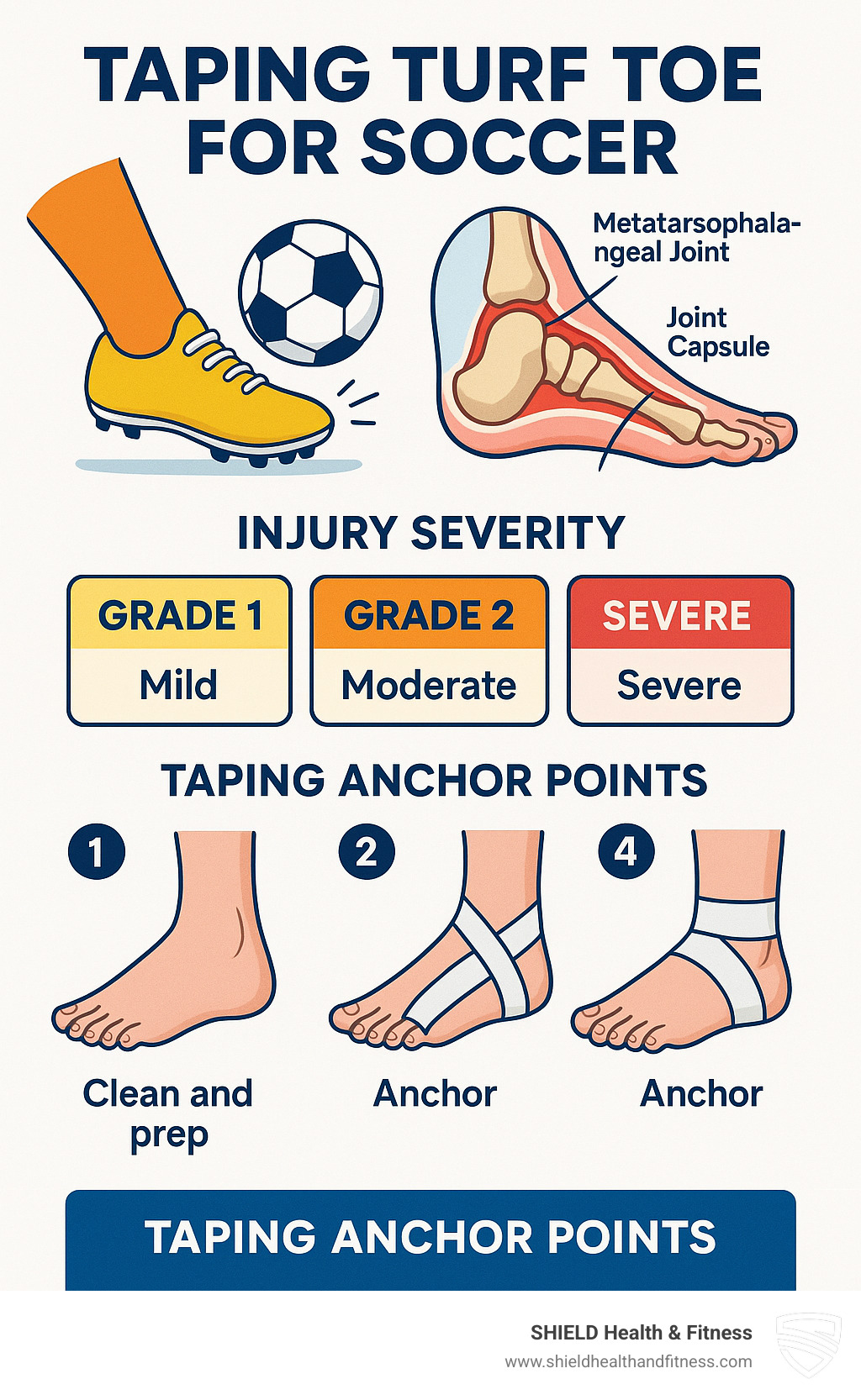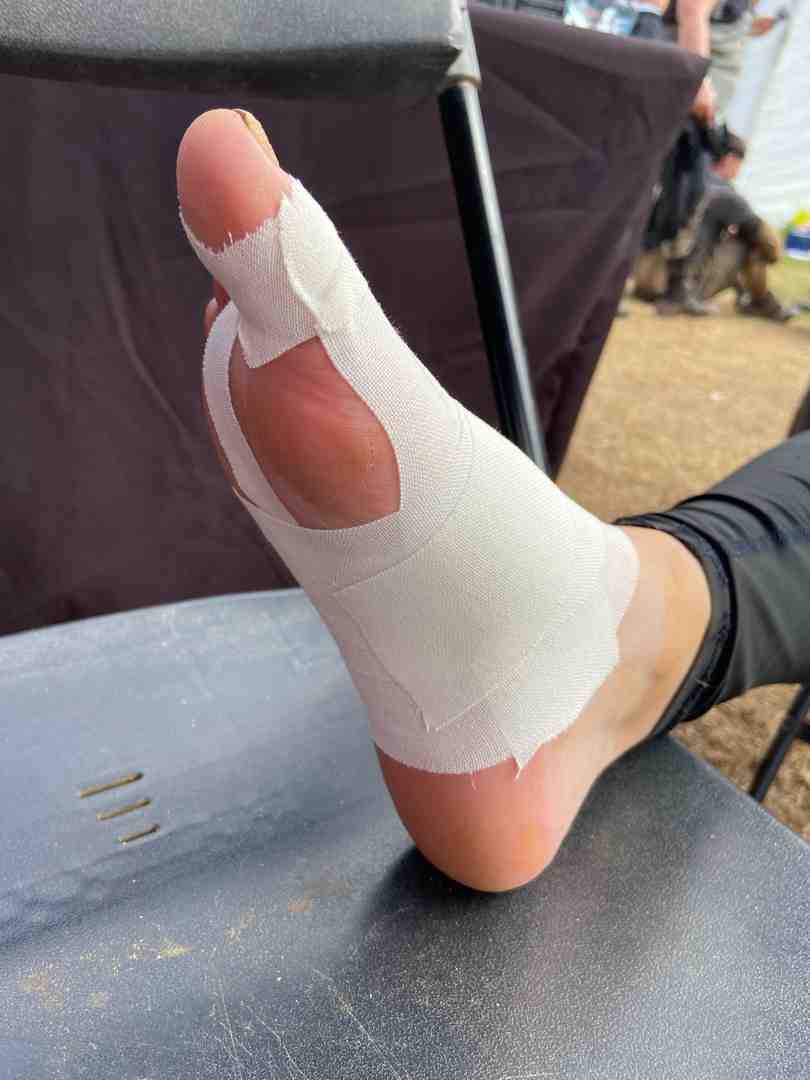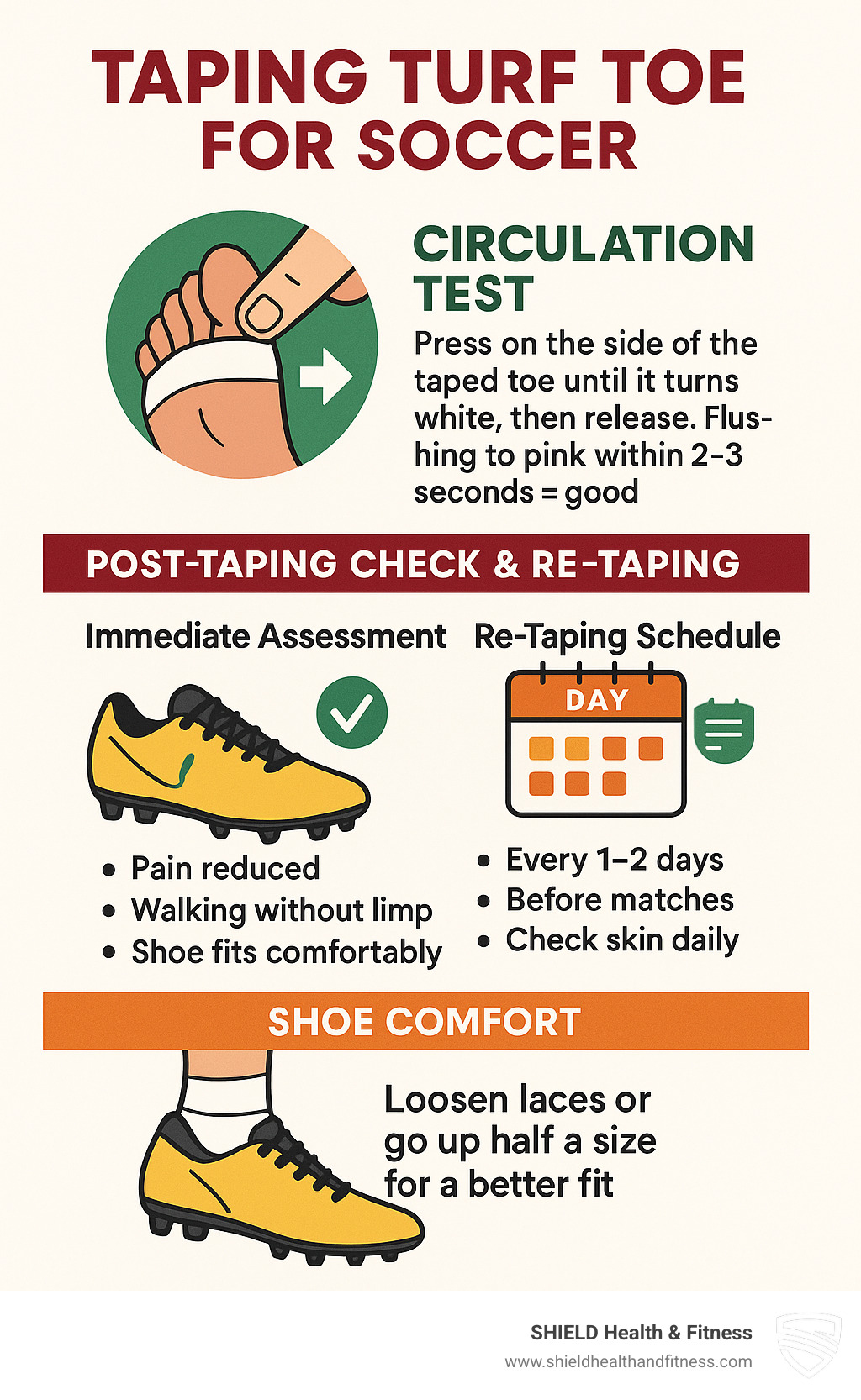Big Toe, Big Problem? Master Turf Toe Taping for Soccer
Why Soccer Players Need to Master Turf Toe Taping

Taping turf toe for soccer, lacrosse, football and other sports played frequently on artificial turf surfaces is a critical skill that can mean the difference between staying on the field and sitting on the sidelines for weeks. Here's what you need to know:
Quick Answer for Taping Turf Toe:
- Clean and prep the skin around your big toe
- Anchor 2.5cm zinc oxide tape at toe base and mid-foot, or use the alternate stretch tape technique
- Apply 3-5 support strips from toe to mid-foot with tension
- Lock off with circular tape wraps
- Test circulation - toe should flush pink within 2-3 seconds
Turf toe - a sprain of your big toe's main joint - has plagued soccer players since artificial turf became popular in the 1970s. This injury happens when your big toe hyperextends (bends too far backward), typically when your foot stays planted while your body moves forward during sprints, tackles, or sudden direction changes.
The stakes are high. Grade 1 turf toe might sideline you for a week, but Grade 3 injuries can keep you off the field for 2-6 months. That's why learning proper taping technique is essential for any serious soccer player.
Research shows that taping combined with proper rehabilitation can reduce pain significantly improve your ability to walk and play after an injury. A recent clinical trial found that players using kinesiology tape alongside exercise therapy had much better outcomes than those relying on exercise alone.
I'm Josh Key, and I am part of the team at SHIELD Health and Fitness; at SHIELD we have spent years working with athletes on injury prevention and recovery solutions across all sports. Through product testing with professional athletes, we have seen how proper taping turf toe for soccer can keep players in the game when applied correctly.

Turf Toe 101: Why Soccer Players Get It and How Bad Can It Be?
To understand why taping turf toe for soccer is so crucial, you need to know what's really happening inside your big toe when things go wrong.
Your big toe joint - doctors call it the first metatarsophalangeal (MTP) joint - handles about 8 times your body weight during normal walking and running. When you're flying down the field chasing a through ball? That force gets even more intense.
The Hyperextension Trap
Here's the scenario that trips up countless soccer players: You're charging toward goal, your foot plants on the turf, but your body keeps rocketing forward. Your big toe gets yanked backward way beyond where it's supposed to go - that's hyperextension in action.
All those ligaments, tendons, and soft tissues that normally keep your MTP joint happy? They're suddenly stretched to their breaking point or torn outright.
This exact mechanism is why turf toe exploded onto the scene after artificial turf became popular in the 1970s. That harder, grippier surface means your foot sticks while your momentum carries you forward.
Understanding the Three Grades
Not every turf toe injury is the same. Medical professionals break them down into three distinct grades.
Grade 1 injuries involve ligament stretching with tiny micro-tears. You'll feel mild pain and swelling, maybe no bruising at all. You're usually back in action within about a week.
Grade 2 injuries mean partial ligament tears. Now you're looking at moderate pain, swelling, and bruising that's hard to ignore. Your toe won't move like it used to, and you're sidelined for 2-3 weeks typically.
Grade 3 injuries are the nightmare scenario - complete ligament disruption. The severe pain, significant swelling, and bruising make it impossible to move your toe normally. You could be out for 2-6 months, and surgery might be on the table.
Symptoms That Signal Trouble
Your body sends pretty clear warning signals when turf toe strikes. That sharp pain at the base of your big toe isn't something to play through. When your cleat suddenly feels tight from swelling, or you notice bruising creeping around the toe joint, it's time to pay attention.
Stiffness and limited toe movement are red flags too. If pushing off or changing direction sends shooting pain through your foot, you're not doing yourself any favors by trying to tough it out.
The artificial turf revolution created a whole new category of soccer injuries, which is exactly why mastering proper taping turf toe for soccer became essential knowledge for players at every level. Scientific research on turf toe injuries consistently shows that catching these injuries early and providing proper support makes all the difference in your recovery timeline.
Does Taping Work? Benefits, Limits, and When to Start
Here's what every soccer player wants to know: Does taping actually help turf toe, or is it just wishful thinking?
Taping absolutely works - but it's not a magic fix that lets you ignore the injury completely.
The Research That Supports Tape Applications for Turf Toe
A recent clinical trial gave us some eye-opening results about taping turf toe for soccer. Researchers followed players who used kinesiology taping combined with exercise therapy, and the numbers were impressive:
The pain scores dropped by 85.8% - that's going from "ouch, this really hurts" (6.35 out of 10) to "barely noticeable" (0.90 out of 10). Players could also walk 21.6% farther during fitness tests, and their overall movement quality improved significantly.
Three Ways Taping Helps You Heal
Pain relief happens because tape takes pressure off inflamed tissues around your big toe joint. Your brain gets distracted from the pain signals and focuses on the supportive sensation instead.
Joint stability is where rigid sports tape really shines. It acts like an external ligament, physically preventing your big toe from bending too far backward. This protection lets your natural ligaments heal without constantly getting re-injured.
Better body awareness - technically called proprioception - comes from the continuous feedback the tape provides. Your brain gets constant updates about where your toe is positioned, which improves your balance and helps prevent awkward movements that could cause re-injury.
How Taping Stacks Up Against Other Treatments
When you're dealing with turf toe, you've got several options. Rigid sports tape gives you excellent stability and high pain relief, but it does limit your mobility somewhat. Stretch Tapes (Like SHIELD Reflex) and Kinesiology tapes (such are SHIELD APEX) offers good stability with better mobility, making it perfect for gradual return to play.
Pure rest costs nothing and gives you full mobility, but it doesn't provide any stability or significant pain relief. Orthotics and physical therapy are excellent long-term solutions, but they're more expensive and less convenient than tape.
The scientific research on kinesiology taping benefits consistently shows that combining taping with other treatments produces the best outcomes. Just like we recommend a comprehensive approach to skin protection in our Protect Your Skin from the Gridiron Grind guide, your turf toe recovery works best with multiple strategies working together.
Timing Your Taping Strategy
The best time to start taping is immediately after injury - assuming you've ruled out fractures or severe Grade 3 tears that might need surgery. For minor injuries, you can begin taping within hours. For more serious injuries, wait until the initial swelling goes down, usually 24-48 hours.
Grade 1 injuries often allow return to play within 3-7 days with proper taping support. Grade 2 injuries typically need 1-2 weeks of rest before gradual return with taping. Grade 3 injuries require extended rest and professional medical clearance before any return to play.
What Taping Can and Cannot Do
Let's be honest about expectations. Taping can reduce your pain, provide meaningful stability, and allow you to stay active during recovery.
But taping cannot make torn ligaments heal faster, prevent every possible re-injury, or replace proper rest when your body needs it. It's a powerful tool in your recovery toolkit, not a miracle cure that lets you completely ignore the injury.
Step-by-Step Guide: Taping Turf Toe for Soccer
Now for the main event - learning how to properly tape turf toe for soccer. I've refined this technique through years of working with professional athletes, and it's the same method trusted by pro teams across America.

Think of taping like building a bridge - you need solid foundations at both ends and strong support beams connecting them. Your big toe and mid-foot become the anchor points, while the tape strips create the supportive structure that keeps everything stable during play.
Before we dive into the technique, let's get everything ready. Just like our approach to How to Tape Ankles for Soccer, preparation makes all the difference between tape that stays put and tape that fails when you need it most.
For taping to isolate, you would use rigid tape. You'll need 2.5cm zinc oxide tape (our Shield Signature Athletic Tape 3pk works perfectly for this), 5cm elastic adhesive bandage, scissors, a clean towel, and optionally some pre-tape adhesive spray if you tend to sweat heavily.
Supportive taping for rehabilitation but not for toe isolation may call for stretch tapes or kinesiology tapes. Our shield Reflex lightweight stretch tape and our APEX kinesiology tapes are perfect examples of these.
Pre-Tape Prep
Getting your skin ready is like preparing a canvas for painting - skip this step, and your masterpiece won't last long. Start by washing your foot thoroughly with soap and water, then dry it completely. Any moisture, oils, or leftover soap will turn your tape job into a soggy mess within minutes of play.
If you've been using lotions, sunscreen, or any other products on your feet, clean them off with rubbing alcohol. These products create a slippery barrier that prevents proper tape adhesion.
For players with particularly sweaty feet or those playing in humid conditions, a light spray of pre-tape adhesive creates a tackier surface that helps tape stick better.
Finally, position your big toe in a neutral position - not pointing up or down, just naturally relaxed. Slightly fan your toes apart to allow for the natural foot expansion that happens during activity.
Tape Types & Cutting Tips
Understanding your tape options helps you choose the right tool for the job. Zinc oxide tape is your heavy-duty option - rigid, waterproof, and designed to restrict movement. The 2.5cm width works perfectly for most feet, though players with larger feet might prefer 3.8cm tape for better coverage.
Kinesiology tape offers more flexibility and comfort for extended wear. Recent research shows it's most effective when applied with 50% stretch through the middle section and zero stretch at the anchor points.
Here's a pro tip that saves time and improves results: cut all your strips before you start taping. Pre-cut 3-5 support strips, each about 6-8 inches long, and round off the corners with scissors. Sharp corners catch on socks and peel up during play.
Taping Turf Toe for Soccer: 5 Essential Steps
Step 1: Build Your Foundation Every good tape job starts with solid anchors. Circle the base of your big toe with zinc oxide tape, applying it firmly but not tightly - you should be able to slide a finger underneath. This becomes your toe anchor.
Create your second anchor around your mid-foot, roughly halfway between your toes and heel. This mid-foot anchor prevents the entire tape job from sliding forward or backward during play.
Step 2: Create Your Support Network Take your pre-cut support strips and apply them one by one, running from the toe anchor to the mid-foot anchor. Start with the strip that runs along the top of your foot, applying moderate tension - firm enough to provide support, but not so tight that it cuts off circulation.
Work your way around your foot, applying strips to the sides. Overlap each strip by about two-thirds to ensure complete coverage without gaps.
Step 3: Lock Everything Down Circle both your toe and mid-foot anchors again with fresh tape, securing the ends of all your support strips. This prevents the strips from peeling up when you make sharp cuts or sprint.
Step 4: Add the Finishing Touch Apply your 5cm elastic adhesive bandage over the entire taped area, starting at your toe and working toward your mid-foot. This over-wrap adds compression, helps secure the underlying rigid tape, and creates a smoother surface that won't catch on your sock.
Step 5: The Crucial Safety Check Never skip the circulation test - it could save you from serious injury. Press firmly on the side of your taped toe until it turns white, then release. Your toe should flush pink within 2-3 seconds. If it takes longer, the tape is too tight and needs to be removed and reapplied.
Post-Taping Check & Re-Tape Schedule
Right after taping, do a quick assessment walk. Your pain should be reduced to 3 out of 10 or less, and you should be able to walk without limping. If you're still in significant pain, the injury might be more severe than initially thought.
Your cleat fit will change with the added tape thickness. Don't try to force your foot into the same tight fit - loosen your laces or consider going up half a size if you'll be taping regularly.
Re-taping becomes part of your routine when you're recovering from turf toe. For daily training, plan to re-tape every 1-2 days as the adhesive loses its grip and the tape stretches out. On match days, always apply fresh tape regardless of when you last taped.
Check your skin daily for any signs of irritation, blisters, or breakdown. Red, raw, or broken skin means you need to take a day off from taping to let your skin recover.

Beyond Tape: Recovery Timeline and Injury Prevention
Taping turf toe for soccer is your first line of defense, but it's just the beginning of your recovery journey. The smart approach combines immediate support with a solid recovery plan.
The RICE Protocol Foundation
The old-school RICE protocol still forms the backbone of early turf toe treatment, and it works beautifully alongside your taping routine. "RICE" stands for : Rest; Ice; Compression; Elevation.
Rest doesn't mean becoming a couch potato - it means being smart about what you ask your injured toe to do. Light walking around campus or work is usually fine, but save the sprinting and cutting moves for when your toe is ready.
Ice becomes your best friend for the first few days. Apply ice packs for 15-20 minutes every 2-3 hours during those crucial first 48-72 hours. Here's a pro tip: you can ice right over your tape without removing it, which saves you the hassle of constant re-taping.
Compression is already handled by your tape job, but you can add an elastic bandage during rest periods for extra support. Elevation is simple - prop that foot up above your heart when you're watching Netflix or studying.
Smart Medication Use and When to See a Pro
Over-the-counter anti-inflammatories like ibuprofen or naproxen can help manage pain and swelling during those first tough days. But don't use medication to mask pain so you can play through injury.
If you're dealing with severe pain, can't bear weight, or suspect a Grade 3 injury, get professional medical attention. Some injuries need more than tape and time.
Game-Changing Footwear Modifications
Your cleats can either help or hurt your recovery. Stiff-soled cleats are your friend right now - they resist bending at the toe and prevent accidental hyperextension during play.
Carbon plate insoles are another secret weapon used by professional players. These rigid inserts slip into your existing cleats and limit toe motion during play. They work for both treatment and prevention.
Don't forget about proper fit either. Cleats that are too long can cause your toe to jam against the front during sudden stops, undoing all your careful taping work.
Your Recovery Roadmap by Injury Grade
Grade 1 injuries typically follow a one-week timeline: spend the first three days focusing on the RICE protocol while doing gentle range-of-motion exercises. By days four and five, you can usually start light jogging if you're pain-free. Days six and seven often mark your return to full training, but keep that tape job solid.
Grade 2 injuries need more respect - we're talking 2-3 weeks of structured recovery. Your first week focuses on RICE and protected weight-bearing. Week two introduces progressive loading and balance exercises. Week three typically sees a return to sport-specific movements.
Grade 3 injuries are the big leagues of turf toe - 2-6 months of recovery time. The first couple weeks might involve immobilization and close medical supervision. Weeks 3-8 center around a progressive rehabilitation program. The final phase involves gradual return to sport with extensive taping support.
Building Stronger Feet Through Exercise
Another aspect is important to bring up whenever we talk about toe or foot injuries - building strength and balance that prevents future injuries. Toe curl exercises might look silly, but they're incredibly effective. Place a towel on the floor and use your toes to scrunch it toward you. This strengthens all those small muscles that support your big toe joint.
Balance training is where you really build resilience. Start by standing on one foot for 30-60 seconds, then progress to unstable surfaces like foam pads. This improves your proprioception - basically your body's ability to know where your foot is in space - which dramatically reduces re-injury risk.
Don't neglect calf raises either. Strong calf muscles help control the forces that travel down to your toe during the push-off phases of running and jumping.
Just like we emphasize in our guide on Sports Tape for Fingers: A Guide, consistency in your rehabilitation routine makes all the difference between a one-time injury and a chronic problem.
The scientific research on rehabilitation consistently shows that combining multiple treatment approaches produces the best long-term outcomes. Taping turf toe for soccer is crucial, but it's most effective when paired with proper rest, smart training modifications, and targeted exercises that address the root causes of injury.
Frequently Asked Questions about Taping Turf Toe for Soccer
I get these questions all the time from soccer players dealing with turf toe injuries. Let me share the answers that have helped thousands of athletes get back on the field safely.
How long should I keep my toe taped?
This depends entirely on how severe your injury is. Think of taping like a cast - you need it until your body has healed enough to support itself.
For Grade 1 injuries (about 1 week), you'll typically need taping until you can push off your big toe without any pain during light jogging. Most players find this takes 5-7 days with proper rest and care.
Grade 2 injuries (2-3 weeks) require more patience. Even after the initial pain fades, those partially torn ligaments need extra support while they rebuild their strength. I always tell players to continue taping turf toe for soccer through their entire return-to-training period.
Grade 3 injuries (6 weeks or longer) are the marathon of turf toe recovery. You might need taping support for several months after returning to play. These severe injuries often require working closely with a sports medicine professional.
Here's my simple test: if removing the tape causes immediate pain or makes your toe feel unstable, you're not ready to go without support yet.
Can I play matches while taped?
You're cleared for match play when you can walk pain-free, jog without limping, and push off your big toe with full confidence. Your toe should have good range of motion in all directions except the one that caused your injury in the first place.
Always apply fresh tape before each match or training session. Old tape is like a worn-out tire - it might look okay, but it won't perform when you need it most. I recommend taping 30-60 minutes before kickoff to let the adhesive set properly.
During your warm-up, test your push-off power and cutting movements. If anything feels off, don't ignore it. Make sure your cleats still fit comfortably with the added bulk of tape.
What if taping turf toe for soccer increases pain?
Stop playing immediately if taping makes your pain worse. This is your body's way of telling you something isn't right, and pushing through increased pain almost always leads to more serious injury.
Increased pain usually happens for one of four reasons. Too-tight taping is the most common culprit - if you've cut off blood flow or put excessive pressure on swollen tissues, your toe will definitely let you know. Remove the tape completely and reapply with gentler tension.
Poor technique can actually stress your injured ligaments more than helping them. If you're new to taping, consider having an experienced teammate or trainer check your work.
Underlying complications like fractures or Grade 3 tears might not respond well to basic taping. Severe pain despite proper technique often means you need medical evaluation, not more tape.
Some players develop skin reactions to tape adhesive, especially with daily use. If your skin becomes red, itchy, or develops a rash, switch to hypoallergenic tape or use an underwrap barrier to protect your skin.
The bottom line? Pain is information. Listen to what your body is telling you, and don't try to tape your way through a serious injury that needs professional medical attention.
Conclusion
Learning to master taping turf toe for soccer isn’t just about managing an injury—it’s about taking control of your game and your recovery.
Your taping success depends on a few key principles: start early, use quality materials, check circulation, and remember that tape is your teammate, not your cure. Rigid zinc oxide tape supplies stability, while proper application ensures maximum benefit without compromising comfort.
The best athletes think prevention first. They invest in proper footwear, listen to their bodies, and address small problems before they become big ones. Taping turf toe for soccer is invaluable, but avoiding the injury altogether is even better.
Turf toe will probably happen at some point if you play seriously. When it does, you’ll be ready—you’ll know how to support healing, when to push, and when to rest.
At SHIELD Health & Fitness, we’ve spent years perfecting athletic tape specifically for moments like these. Our American-made products deliver consistency, reliability, and performance when your season is on the line. Whether it's classic cotton rigid tapes or stretch - and - tear options for simplicity, all the way to high-performance kinesiology tape - we have you covered.
Your big toe might seem small, but it powers your push-off, sprint, and shot. Take care of it, and when injury strikes, you’ll have the tools and knowledge to get back to what you love.
Ready to gear up with professional-quality tape? Check out our complete selection of Soccer Tape & Protection Products and play with confidence.

